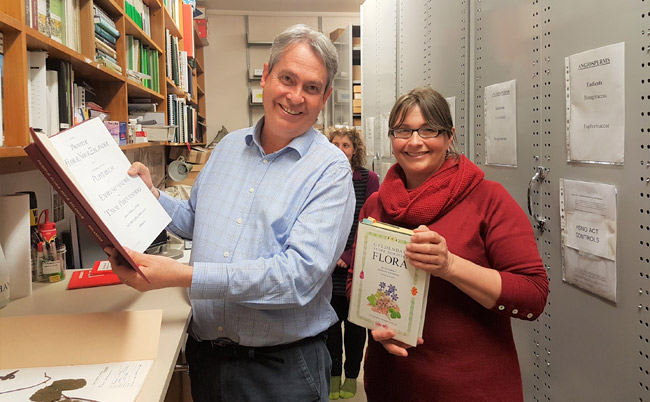Wednesday 10 October 2018 9:19pm

Sweden's Ambassador to New Zealand His Excellency Mr Par Ahlberger (left) with the Department of Botany's Associate Professor Janice Lord, during Mr Ahlberger's recent visit to Otago.
Forging new connections based around botanical ties was central to a recent visit to Otago by Sweden’s Ambassador to New Zealand.
His Excellency Mr Par Ahlberger’s visit was a precursor to next year’s 250th anniversary of Cook’s first landing aboard the HMS Endeavour. On that voyage was Swedish naturalist Daniel Solander who collected specimens and produced the first documented list of New Zealand’s flora.
The Ambassador’s time in Dunedin focused on botanical themes including a tour of the country’s oldest botanical gardens and visiting the University’s Department of Botany, the only dedicated department to the subject in New Zealand.
Associate Professor Janice Lord says Dunedin has a long history as a hub of botanical exploration, and having the oldest University means many of the early samples were identified here.
"The work of Solander binds both our countries and has given us an occasion for conversation on topics we both highly regard, such as botany, biodiversity and sustainability."
“Having a dedicated Botany Department here is testament to that rich history, and the ongoing demand for a well-rounded plant orientated education.”
The Department hosts an internationally recognised lending herbarium, and Mr Ahlberger toured the 70,000-strong collection that features a large number of lichen and southern alpine species.
Also on display was a copy of Solander’s 1770 unpublished Primitiae Florae Novae Zelandae (First Fruits of the Flora of New Zealand). As the first documented list of native flora, Solander extended credit to fellow Polynesian Tupaia for his crucial role communicating with Māori to translate and document the first plant names.
Flora links common to both Sweden and New Zealand include some alpine grasses and herbs, as well as ‘bipolar’ lichens, which occur only at the northern and southern limits of the planet.
However the purpose of the Ambassador’s visit was also to foster new links ahead of the opening of a New Zealand embassy in Stockholm.
“The work of Solander binds both our countries and has given us an occasion for conversation on topics we both highly regard, such as botany, biodiversity and sustainability,” Mr Ahlberger says.
Potential opportunities between Sweden and the Department such as reciprocal arrangements for visiting botanists, research, and student exchange programmes were discussed.
“This meeting not only celebrates our historical botanical connection, but also future ties for transferring knowledge.”
